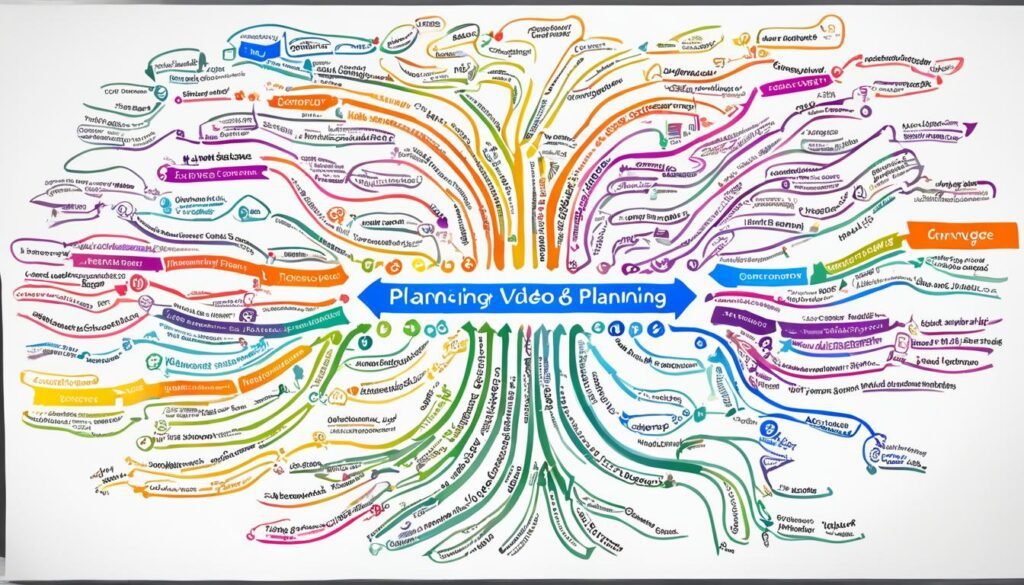Did you know that video was forecasted to account for 81% of total consumer internet traffic in 2021? If you’re looking to create professional-looking videos for any purpose, this article will provide you with tips and best practices to improve the quality and engagement of your videos. Planning ahead, using the right camera, lighting, and audio equipment, and creating a strong story are just a few of the elements that will help take your video creation to the next level. Let’s dive in!
Key Takeaways:
- Plan ahead to identify your goals, target audience, and choose suitable keywords.
- Use the right camera and lighting to enhance the visual quality of your videos.
- Invest in a good microphone and audio equipment to ensure clear and high-quality audio.
- Create engaging openings and thumbnails to capture and retain your viewers’ attention.
- Always consider your audience’s preferences and deliver personalized videos for maximum engagement.
Planning Your Video for Success
Before creating a video, it’s important to plan and strategize to ensure its success. This involves setting clear goals, understanding your target audience, conducting keyword research, and making informed decisions about the video type and location.
Goal Setting
Start by defining your goal for the video. Are you looking to promote a product, educate your audience, or entertain them? By clarifying your objective, you can tailor your video content and messaging accordingly.
Identifying Your Target Audience
Knowing your target audience is crucial for creating relevant and engaging videos. Consider their demographics, interests, and pain points. This information will help you write a script, choose visuals, and distribute your video effectively.
Keyword Research
Conducting keyword research is essential for optimizing your video for search engine rankings and reaching a wider audience. Identify the keywords and phrases relevant to your video topic and incorporate them naturally throughout your script and video description.
Selecting the Right Video Type
Deciding on the most suitable video type will depend on your goals and target audience. Whether it’s a tutorial, testimonial, interview, or product demonstration, choose a format that aligns with your message and effectively captures your audience’s attention.
Script Writing
A well-written script is the foundation for a successful video. Craft a compelling story, include a strong call-to-action, and ensure the flow and pacing are engaging. Consider using bullet points or a storyboard to outline the key points and visuals for each scene.
Location Selection
The location of your video can significantly impact its quality and message. Whether you’re shooting indoors or outdoors, choose a setting that complements your content and enhances the visual appeal. Ensure the location reflects your brand and resonates with your target audience.

By following these planning steps, you’ll be well-equipped to create a video that resonates with your target audience and achieves your goals. The next section will delve into using the right camera and lighting to further enhance the quality of your videos.
Using the Right Camera and Lighting
The camera you use will significantly impact the quality of your videos. While smartphone cameras have improved in recent years and can produce high-quality videos, professional cameras offer more control and features for video production. Consider your budget and the specific needs of your video when choosing a camera.
Lighting is another crucial aspect to consider. Natural lighting can be a great option for beginners, as it is readily available and can create a pleasing aesthetic. However, it is important to be mindful of the time of day and the position of the sun to avoid harsh shadows or overexposure. On the other hand, studio lighting provides consistent and controlled lighting conditions, allowing you to create a professional look and feel. It offers flexibility in terms of intensity, color temperature, and the ability to manipulate shadows.
Ensure that your videos are well-lit to create a visually appealing experience for your audience. Experiment with different lighting setups and techniques to achieve the desired mood and ambiance for your videos. Whether you choose natural lighting or studio lighting, the key is to carefully balance and distribute the light to highlight the subject and eliminate any distracting shadows or glares.
Enhancing Audio Quality
The audio quality of your video is essential for delivering a professional and engaging experience. When it comes to capturing clear and high-quality audio, using the right equipment is crucial. One of the key components is a microphone that suits your specific needs and ensures excellent audio capture. In this section, we will explore different types of microphones and discuss how they can enhance the overall impact and effectiveness of your videos.
Types of Microphones
There are several types of microphones available in the market, each with its own unique features and applications. Here are three commonly used microphones for video production:
- Condenser Microphone: Known for their sensitivity and accuracy, condenser microphones are ideal for capturing vocals and detailed audio. They require a power source, such as a battery or phantom power, and are commonly used in controlled studio environments.
- Dynamic Microphone: Dynamic microphones are robust and versatile, making them suitable for various recording situations. They are known for their durability and can handle high sound pressure levels, making them a popular choice for live performances and interviews.
- Lavalier Microphone: Lavalier microphones, also known as lapel microphones, are small and discreet. They are commonly used for capturing audio in situations where a microphone needs to be attached to a person’s clothing, such as interviews or presentations.
Choosing the right microphone depends on factors such as the recording environment, the type of audio you want to capture, and your budget. If you are unsure which microphone to choose, consider consulting professionals or conducting thorough research to find the best fit for your specific needs.
Investing in Audio Recorders
In addition to choosing the right microphone, using a dedicated external audio recorder can significantly enhance the audio quality of your videos. While some cameras have built-in audio recording capabilities, external recorders offer more control and features for capturing high-quality audio.
Here are a few benefits of using an audio recorder:
- Improved audio fidelity: Dedicated audio recorders have superior preamps and converters, resulting in cleaner and more accurate sound reproduction.
- Separate audio control: With an external audio recorder, you can adjust and monitor audio levels independently from the camera, ensuring optimal sound quality.
- Flexibility in post-production: Recording audio separately allows for greater flexibility during the editing process, enabling you to fine-tune and enhance the audio to perfection.
Investing in an audio recorder is a wise choice if you want to take your video’s audio quality to the next level.
Enhancing the Audio Experience
Once you have the right microphone and audio recorder, there are a few additional tips to enhance the overall audio experience:
- Position the microphone correctly: Experiment with microphone placement to find the sweet spot where it captures clear and balanced audio.
- Monitor audio levels: Keep an eye on audio levels during recording to avoid clipping or distortion.
- Minimize background noise: Choose a quiet location or use soundproofing techniques to reduce unwanted background noise.
By paying attention to audio quality and utilizing the appropriate equipment and techniques, you can ensure that your videos deliver a professional and engaging audio experience.

Creating Engaging Openings and Thumbnails
The first 15 seconds of your video are crucial in capturing and retaining your viewers’ attention. A strong opening, with a clear hook and engaging visuals, can make a significant difference in viewer retention. Including your brand logo and a clear headshot in the opening can help create a connection with your audience.
Additionally, thumbnails play a vital role in attracting viewers and conveying the content of your video. Using captivating visuals and clear text in your thumbnail can entice viewers to click and watch your video. Don’t forget to include a call to action (CTA) in your videos to prompt your viewers to take the desired action, such as subscribing, sharing, or visiting your website.
Here are some tips to create engaging openings and thumbnails:
- Start with a hook: Grab your viewers’ attention right from the start with an intriguing question, shocking statement, or compelling story. Make sure it relates to the content of your video and entices viewers to keep watching. For example, if you’re creating a cooking tutorial, you could start with a hook like, “Are you tired of bland meals? Discover the secret ingredient that will transform your cooking!”
- Showcase your brand: Include your brand logo and a clear headshot in the opening of your video. This helps establish your brand identity and creates a personal connection with your audience.
- Create visually appealing thumbnails: Use eye-catching visuals and clear text in your thumbnails to make them stand out among other videos. Choose an image that represents the main theme or topic of your video and add text that summarizes the key benefit or takeaway for viewers.
- Use clear lighting and high-resolution images: Ensure that your video openings and thumbnails have clear lighting and high-resolution images to enhance their visual appeal. Poor lighting or low-quality images can deter viewers and make your content appear unprofessional.
- Add a compelling CTA: Don’t forget to include a call to action in your video openings and thumbnails. Clearly state the desired action you want viewers to take, whether it’s subscribing to your channel, sharing the video, or visiting your website. For example, you could include a CTA like, “Subscribe now to never miss another exciting adventure!”
Conclusion
Creating high-quality videos doesn’t have to be complicated. By following these video creation tips and best practices, you can elevate your skills and produce professional-looking videos that captivate your audience.
Start by planning your videos, understanding your goals, and identifying your target audience. This strategic approach will help you create content that resonates and engages with your viewers.
Next, make sure to use the right equipment, such as a video camera and suitable lighting, to enhance the visual quality of your videos. Pay attention to audio quality as well, using a microphone that suits your needs to ensure clear and professional sound.
Lastly, create engaging openings and thumbnails that grab your viewers’ attention and entice them to watch your videos. By incorporating your brand logo and a clear hook, you can establish a strong connection with your audience from the start.
By implementing these video creation tips, you can enhance the overall quality, engagement, and success of your videos. Remember to always consider your audience and their preferences when creating content. So, go ahead and start creating captivating videos today with Make-a-Video!
FAQ
Why is planning important before creating a video?
Planning helps set a goal, identify the target audience, and conduct research on the topic, leading to a more effective video.
How does the choice of camera impact video quality?
The camera used significantly affects video quality. Professional cameras offer more control and features, while smartphone cameras are suitable for high-quality videos on a budget.
What role does lighting play in video production?
Lighting is crucial for visually appealing videos. Natural lighting is great for beginners, while studio lighting elevates the look and feel of the videos.
How can audio quality be improved in videos?
Using a dedicated external audio recorder and a suitable microphone, such as a condenser, dynamic, or lavalier microphone, enhances audio quality significantly.
Why is the opening of a video important?
The first 15 seconds of a video are crucial in capturing and retaining viewers’ attention. A strong opening with engaging visuals and a clear hook increases viewer retention.
What is the importance of thumbnails in videos?
Thumbnails attract viewers and convey the video’s content. Using captivating visuals and clear text in the thumbnail entices viewers to click and watch the video.
How can I create professional-looking videos?
By planning videos, using the right equipment, optimizing audio and lighting, and creating engaging openings and thumbnails, you can elevate your video creation skills and produce professional-looking videos.







